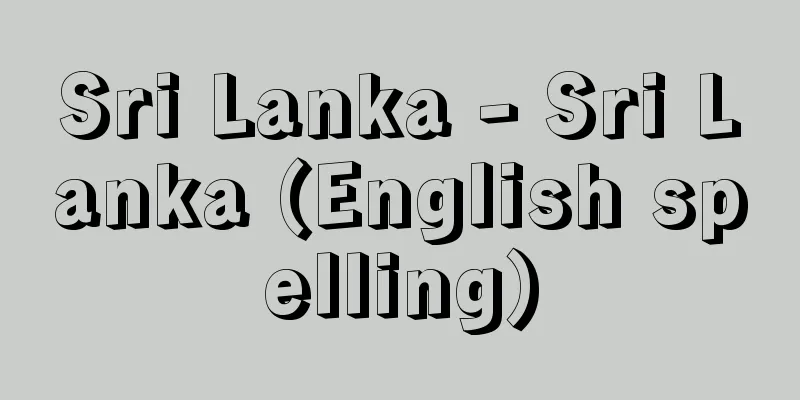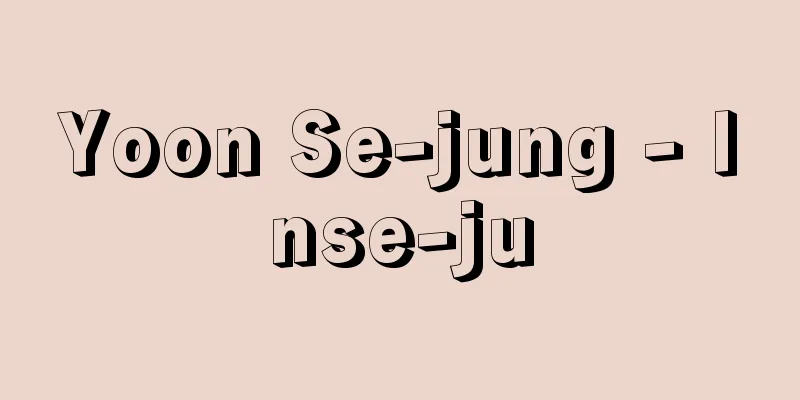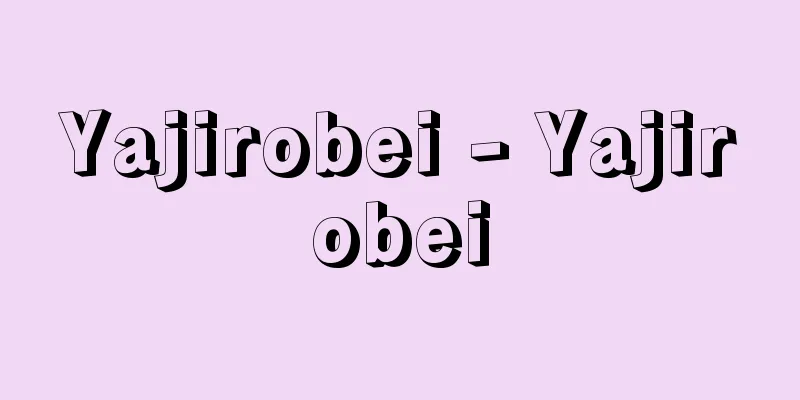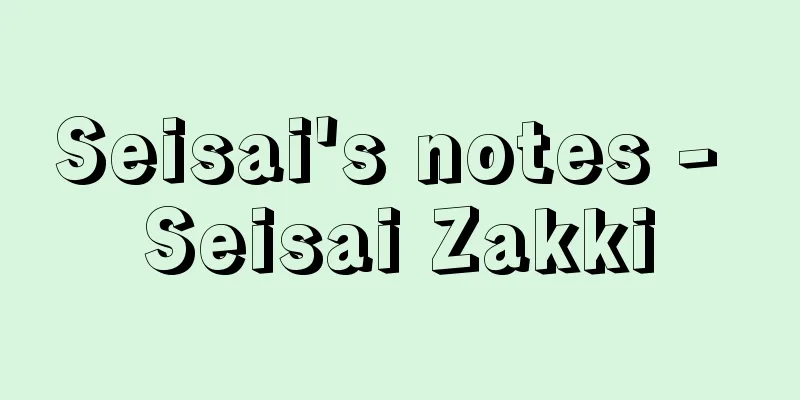Sri Lanka - Sri Lanka (English spelling)

|
A country consisting of the island of Ceylon in the Indian Ocean southeast of the Indian peninsula. Its official name is the Democratic Socialist Republic of Sri Lanka, Sri Lanka Prajatantrika Samajavadi Janarajaya. In English, it is called the Democratic Socialist Republic of Sri Lanka. Its former name was Ceylon. Its area is 65,610 square kilometers, and its population is 18,797,000 (2001 census), 19,886,000 (mid-2006 estimate). In 1985, the capital was moved from Colombo to the suburb of Sri Jayawardanapura Kotte. [Masatoshi Yoshino] NatureCeylon is shaped like a long, narrow pear from north to south, with mountain ranges in the center, slightly southward, and gradually lowering towards the periphery, from the foothills to the coastal lowlands. The highest peaks in the mountain range are over 2000 meters, such as Mount Biddultalagala (2518 meters) and Mount Adam's Peak (2243 meters), but most of the peaks are between 1500 and 2000 meters, and the only major river, the Mahaweli River (330 kilometers long), originates here. The coastline is monotonous, with well-developed sandbars and lagoons. It is connected to the Indian peninsula by Adam's Bridge, a series of sandbars and shallows, and coral reefs have developed on the wide continental shelf between the northwestern part of the island and the Indian peninsula. The climate is tropical oceanic, and the southwestern part of the island is called the wet zone, where the annual rainfall reaches 4,000 to 5,000 mm in the rainiest area. The remaining three-quarters of the island is called the dry zone, and is relatively dry, with an annual rainfall of 1,000 to 1,200 mm. Colombo, located in the wet zone, has an average annual temperature of 27.5 °C with a small annual range. The annual rainfall is 2,312.9 mm. Nuwara Eliya, a town in the central mountain range, is 1,881 meters above sea level and has an average annual temperature of 15.5 °C. It is a summer resort, and in recent years, vegetable cultivation has become popular, taking advantage of the cool climate. From May to September, rain is heavy in the wet zone, which is the windward slope, due to the west or southwest monsoon. This period is called the Yala season. In contrast, from December to February, the northeast monsoon prevails, and rain falls on the entire island. This period is called the Maha season. Rainfall during these periods is especially important for rice production, and is also of great value as a water resource for electricity and water supply. In the dry zone, reservoirs called tanks, or so-called "tameike" (reservoirs), have been built since ancient times to deal with the unstable rainfall during the Maha season. The northern areas with little rain have a population density of less than 100 people per square kilometer, and have a savanna climate. The northernmost Jaffna Peninsula and the area around Hambantota in the south have strong winds and little rain, and some areas close to the coastline have a dry climate similar to a desert climate. Between the Maha and Yala seasons, the two monsoons alternate, and there are many localized thunderstorms and the amount of rain is unstable. However, rain is important for the sowing and growth of crops, and if there is no rain during this period and the rains of the following monsoon are irregular, it will cause a severe drought. [Masatoshi Yoshino] historyIn 543 BC, Prince Vijaya came to Sinhalese from North India, conquered the indigenous Vedda people and established his first dynasty. This dynasty converted to Buddhism in the 3rd century BC and flourished mainly in northern Sri Lanka, with the capital Anuradhapura reaching its height as the center of Buddhism. Another dynasty was also established in the southeast. The Sinhalese continued to rule the dry zone for about 1000 years afterwards, and had active cultural and racial exchanges with the Tamils of South India. It was even customary for Sinhalese kings to seek queens from the Tamils. In the 11th century, the Tamils of South India invaded Sri Lanka, occupying the capital Anuradhapura and driving the Sinhalese south. However, the Sinhalese defeated the Tamils in 1070 and moved their capital to Polonnaruwa, establishing the "Golden Age of Sinhalese Culture" under the rule of Parakramabahu I (reigned 1153-86). In the 13th century, it was conquered again by the Tamils, and the Sinhalese were divided into many small states, and in the 15th century the north was ruled by the Jaffna Kingdom, the west by the Kotte Kingdom, and the east by the Udarata Kingdom. Ancient settlements from before the Common Era to after the Common Era were limited to the relatively dry areas in the north and in the lowland valleys. In the dry areas, as mentioned above, advanced construction techniques for reservoirs and irrigation facilities called tanks were developed. Numerous small tanks were built throughout the country, and Anuradhapura and Polonnaruwa are good examples. Some of them are still in use today. There are various theories as to why the "Golden Age of Sinhalese Culture" declined. Namely, the government weakened due to repeated invasions by Tamils, the decline of national power made it impossible to build new irrigation facilities or to maintain and repair them sufficiently, food shortages due to droughts, and population decline due to malaria. In addition, with today's knowledge, the wet zone in the southwest has more rain and seems to be more suitable for agricultural production, so there is also the question of why the ancient state was established in the relatively dry zone. The first reason is probably because the agricultural technology of the time was brought from India and was a technique for irrigating farming in dry areas, and the second reason was that the humid areas of the tropical forests in the southwest were too unsuitable for habitation in terms of transportation, sanitation, etc. Muslims had been trading on the west coast since the 7th century. The Portuguese arrived in 1505, founded Colombo in 1510, expelled the Muslims, and brought European culture, including Catholicism. The Dutch arrived in the 17th century, and Colombo fell to them in 1656. The Sinhalese established the Kingdom of Kandy in the central mountain range and retreated. In the early 19th century, British colonization began. Taking advantage of the internal conflicts in the Kingdom of Kandy, Britain conquered it in 1815, and the Sinhalese dynasty, which had lasted for about 2,300 years, came to an end. The entire island of Ceylon became a British colony, and in the 1820s, the mountains were reclaimed and coffee plantations were opened. Tamils were relocated from South India as laborers and plantation agriculture began. In 1880, coffee was damaged by disease, so the cultivation was switched to tea (black tea). In the 20th century, rubber and coconut plantations were started and were successful. From the second half of the 19th century onwards, national consciousness began to rise under the influence of factors such as the Indian independence movement and the development of self-government within the British Empire, and the new constitution of 1931 established a National Assembly with universal suffrage. After the Second World War, the demand for complete self-government grew, and after the enactment of the Self-Government Constitution in 1946, Ceylon gained independence as a Dominion within the British Commonwealth in February 1948. In April 1956, the Bandaranaike Cabinet was formed and promoted a policy of socialist neutrality. In September 1959, Prime Minister Bandaranaike was assassinated, and in March 1960, the United National Party's Senanayake Cabinet was formed. In July of the same year, the Liberal Party won the general election, and Mrs. Bandaranaike became the world's first female Prime Minister. In May 1972, a new constitution was enacted, the country's name was changed from Ceylon to the Republic of Sri Lanka, and it became a fully independent country that was a member of the Commonwealth of Nations instead of a Dominion of the British Commonwealth. In the general election in May 1977, the Bandaranaike administration was defeated, and the new Prime Minister Jayawardene changed the country from a parliamentary cabinet system to a presidential system, and in February 1978, he became the first President. In September of the same year, a new democratic socialist constitution was promulgated, and the country was named the current Democratic Socialist Republic of Sri Lanka. In October 1982, President Jayawardene held a presidential election without waiting for the end of his term and won a landslide victory. [Masatoshi Yoshino] PoliticsThe political system is a republic that is a member of the Commonwealth of Nations. The head of state is the president, whose term of office is six years, with a third term prohibited. The parliament is unicameral with 225 seats, elected by direct proportional representation elections, with a term of six years. The major political parties are the United National Party (UNP), the Sri Lanka Freedom Party (SLFP), the Japanese People's Liberation Front (JVP), the Tamil National Alliance (TNA), and the National Heritage Party (JHU). Since 1983, conflict between the Sinhalese and Tamils has intensified. In July 1983, Tamil extremists attacked government soldiers in Jaffna, leaving 13 dead, leading to racial conflict in which approximately 400 people died. Several racial riots also occurred between 1984 and 1985. President Jayawardene attempted to find a political solution through an all-party roundtable conference and other means, including the participation of representatives of the Tamil United Liberation Front (the predecessor of the Tamil National Union). In July 1987, the ethnic conflict was temporarily put to an end with the mediation of Indian Prime Minister Gandhi. However, the Sinhalese left-wing extremist JVP, who made up the majority, rebelled against what they saw as excessive concessions to the Tamil minority, leading to political turmoil and the election of President Premadasa of the United National Party in December 1988. In the 1989 election, the United National Party won a majority of seats in parliament, and in May of the same year, at the government's urging, the Tamil armed group, the Liberation Tigers of Tamil Eelam (LTTE), also came to the negotiating table. The withdrawal of Indian troops was not completed by January 1990, and from June of that year, fighting between Tamil extremists and the Sri Lankan and Indian armies intensified again. On May 1, 1993, President Premadasa was assassinated in a bomb attack, and President Wijetunga was born. As a result of the general election in August 1995, the opposition People's Alliance (PA), a left-wing coalition party, defeated the United National Party, and a left-wing government was formed for the first time in 17 years. In the presidential election in November, Prime Minister Kumaratunga became president, and his mother, Bandaranaike, who was also the wife of former Prime Minister Bandaranaike, a key figure in Sri Lankan independence, took up the post of Prime Minister for the third time. On January 31, 1996, a bomb attack occurred in the center of Colombo, but there was little public reaction from Sri Lankan society in general. President Kumaratunga was re-elected in the 1999 presidential election, and the People's Alliance, centered on the Sri Lanka Freedom Party, won the 2000 general election. However, in the 2001 general election, the United National Party became the largest party, and Wickremesinghe of the party became prime minister and formed a cabinet. The Wickremesinghe cabinet concluded a ceasefire agreement with the Liberation Tigers of Tamil Eelam and began peace negotiations, but the negotiations were suspended in 2003. In the 2004 general election, the United People's Freedom Alliance (UPFA), centered on the Sri Lanka Freedom Party and the People's Liberation Front, won, and a new government was formed with Rajapaksa of the Sri Lanka Freedom Party as prime minister. After that, the People's Liberation Front withdrew from the cabinet, but it absorbed opposition members and maintained a majority. In the 2005 presidential election, Rajapaksa defeated Wickremesinghe, leader of the United National Party, and became president. In 2008, the Rajapaksa regime withdrew from the 2001 ceasefire agreement with the Liberation Tigers of Tamil Eelam, causing the agreement to lapse. In terms of policy, China is seeking to strengthen ties with Western countries, and is also strengthening its ties with ASEAN (Association of Southeast Asian Nations), Middle Eastern countries, and Japan. The military is volunteer-based, with a total strength of 150,900, of which 117,900 are in the army, 15,000 in the navy, and 18,000 in the air force (2008). The only time they have fought a major war with Japan is during World War II, when the Japanese navy bombarded the naval port of Trincomalee on the east coast. [Masatoshi Yoshino] Economy and IndustrySince independence, the country has been trying to break out of its economic stagnation, but reforming its colonial-style economic structure has not been easy. Two-thirds of the arable land was used for plantation crops of tea, natural rubber, and coconut palm, which were the three major export products, and the economy was dependent on agriculture, but in recent years industrialization has progressed and clothing products have grown into the largest export item. Tea is a typical plantation crop, produced on large-scale farms developed by Tamil workers who migrated from South India. Even after independence, the British owned 47% of the tea plantations, 34% of the rubber plantations, 68% of the banks, and 90% of the distribution companies, but most of them were nationalized in 1971 and 1975. Tea is grown in mountainous tea plantations at altitudes of 600 to 1,200 meters, and tea grown in highlands, known as highland tea, commands a high price on the market. Sri Lanka's tea production is 311,000 tons (2006), accounting for about 9% of the world's tea production, third after China and India. Most of it is exported, making it about one-fifth of the world market. This is about 10% of Sri Lanka's total exports. Natural rubber is concentrated on plateaus below 500 meters above sea level, and production is 109,000 tons (2006), ranking 8th in the world. Coconuts, the fruit of the coconut, once exceeded 2 million tons per year, but have been declining in recent years. Rice production was only 380,000 tons at the time of independence, but by the end of the 1970s it had increased five-fold to about 1.8 million tons. This was still insufficient to feed the entire population, but in good years it became possible to avoid the need to import rice. This has been largely due to improvements in cultivation techniques and the introduction of better varieties, as well as the expansion of the cultivated area. Compared to around 1950, the cultivated area had almost doubled to about 2 million acres (about 8,000 square kilometers) by 1980. Rain has a large impact on rice production, and is a crucial condition for rice cultivation, especially during the Maha season. If the amount of rain is abnormally low, not only will the Maha season be poor, but the yield will also be low during the following Yala season. Therefore, a comprehensive irrigation plan for the Mahaweli River basin in the northeast was implemented with assistance from various countries around the world. This involves the construction of irrigation facilities in approximately 140,000 hectares of the basin, the development of unused farmland, and the construction of infrastructure (economic foundations) in settlements. Once completed, the outlook for food self-sufficiency, a stable energy supply, and the elimination of unemployment will be bright. In 2006, rice production reached 3,342,000 tons. The country has abundant marine resources, and in 1975 it established a Fisheries Corporation and built a Fisheries Training Center in Negombo. Fish catches have been increasing year by year, and frozen shrimp is an important export item. In 2003, the total catch was 279,110 tons, of which 91% was from marine fishing. It produces graphite, the paint pigment illuminite, and various gemstones. Rubies, sapphires, topaz, and garnets have long been known around the world, with Ratnapura in the southwestern mountains being the center of mining. Although there have been factors that have had a negative impact on the economy, such as natural disasters such as the tsunami (Indian Ocean Tsunami) caused by the Sumatra earthquake that occurred in December 2004, which killed more than 30,000 people and forced approximately 840,000 people to live in evacuation centers, as well as the deterioration of public safety and soaring crude oil prices in recent years, Indonesia has recorded an economic growth rate of over 5%, recording growth rates of 7.4% in 2006 and 6.8% in 2007. Gross domestic product (GDP) in 2007 was $32.35 billion, and GDP per capita was $1,617. The trade volume was 7.74 billion dollars in exports and 11.3 billion dollars in imports (2005). Export items include textiles and clothing products, agricultural products such as tea and rubber, and jewelry, while import items include textiles, machinery, petroleum, and food. The main export destinations and regions are the United States, the United Kingdom, India, and Belgium, while the main import destinations are India, Singapore, Hong Kong, China, and Iran. All railways are state-run, with a total length of 1,449 km (2003). Domestic transport is well developed, with state-run buses connecting various locations. Maritime transport has developed since ancient times as a relay point connecting Europe and Asia, and Colombo remains an important port even today. International air routes, such as those operated by SriLankan Airlines, connect Europe and Japan, helping to attract tourists. [Masatoshi Yoshino] Society and CultureApproximately 73% of the total population of Sri Lanka are Sinhalese of Aryan descent, who live mostly in the southwest and highlands, speak the Sinhalese language, and practice Buddhism. The Dravidian Tamils, who migrated from South India later than the Sinhalese, make up approximately 18% of the total population, live mainly in the north and in dry zones such as the east coast, and practice Hinduism. The Sinhalese are divided into Highland Sinhalese and Lowland Sinhalese, both of which are Buddhists, but have their own caste system that differs from that in India. The Tamils are also divided into Ceylon Tamils, who came to the island early on, and Indian Tamils, who migrated as British plantation workers, and most of the latter belong to the lowest caste. Compared to countries like India, the country has a high level of education among its citizens, with a literacy rate of 91.5% (2007). The education system is a 5-6-2 system, with 5 years of primary education (elementary school), 4 years of lower middle school, 2 years of upper middle school, and 2 years of high school. Compulsory education is from age 5 to 14, and there are public, private, and Buddhist schools. There are universities all over the country, but the University of Peradeniya on the outskirts of Kandy has a well-equipped library and plays a central role in shaping culture. The official languages are Sinhalese and Tamil, but because they are from different linguistic families, English is widely used as a common language. In town, you can hear Ceylon English with an accent similar to Indian English. The main newspapers include the Ceylon Daily News, The Island, Daily Mirror, Dinamina, and Dawasa. The news agencies are PTC News Agency and Langkaput News Agency. Radio is provided by the state-run Sri Lanka Broadcasting Corporation (SLBC) as well as other private broadcasting stations. The government-run ITN Television began broadcasting in 1982. In 2001, the number of television sets owned nationwide reached 2.2 million, and in 2007 there were 14 television channels and 32 radio stations. There are many ruins of Buddhist art influenced by Indian culture in the country, especially in Anuradhapura, the old capital, and Polonnaruwa, which flourished in the Middle Ages, 80 kilometers southeast of Anuradhapura. Many of the excavated artefacts are housed in the National Museum in Colombo. Representative examples are stupas and the associated sculptures. In the centre of Kandy is the Temple of the Tooth Relic, which houses the tooth of Buddha, and is revered by many people and attracts many tourists. The Perahera festival, which usually lasts for 10 days in August, attracts people from far away parts of the country. Peradeniya is also home to the world-famous tropical botanical gardens. [Masatoshi Yoshino] Relations with JapanThe people of the Republic of Korea have a gentle way of life, and perhaps because they share the same Buddhist faith, they have a lot in common with the Japanese, and their feelings towards Japan are also very positive. In terms of trade with Japan, exports to Japan amounted to 19.78 billion yen, and imports from Japan amounted to 39.19 billion yen (2005). Major export items include shrimp, textile products, tea, and tuna, while import items include automobiles, general machinery, textiles, electrical machinery, and construction machinery, making Japan the sixth largest trading partner for both imports and exports. Japan's official development assistance (ODA) to Sri Lanka is 756,251 million yen in loan aid (up to fiscal 2008), 183,129 million yen in grant aid and 60,989 million yen in technical cooperation up to fiscal 2007. Japan is the largest donor country to Sri Lanka. [Masatoshi Yoshino] "Sugimoto Yoshio (ed.), "Asia Reader to Understand Life: Sri Lanka" (1998, Kawade Shobo Shinsha)" ▽ "Karashima Noboru et al. (ed.), "South Asia Dictionary: New Revised and Enlarged Edition" (2002, Heibonsha)" ▽ "Shibuya Toshio and Takakuwa Fumiko (eds.), "Sri Lanka: Visiting People's Lives" (2003, Dandansha)" ▽ "Kawashima Koji, "Sri Lanka and the Ethnic Groups" (2006, Akashi Shoten)" [References] | | | | | | | | | | | | | | | | | [Additional resources] |"> Sri Lanka flag ©Shogakukan Illustration/Shogakukan Creative "> Sri Lanka location map The capital of the Central Province, known as a tourist city. It was the last capital of the Singhali dynasty, and the old town spreads out around the artificial Kandy Lake. World Heritage Site "Holy Land of Kandy" (Sri Lanka, registered in 1988) Kandy, Sri Lanka ©Shogakukan "> Kandy city A rocky mountain about 180 meters high that means "lion mountain". A fortress was built by King Kassapa and it became the center of the capital. World Heritage Site "Ancient City of Sigiriya" (Sri Lanka, registered in 1982) Sigiriya, Sri Lanka ©Shogakukan "> Sigiriya Of the six depressions on the western slope of the rock mountain, four have murals remaining. Two of the caves have paintings of 12 voluptuous female figures. Part of the World Heritage Site "Ancient City of Sigiriya" (Sri Lanka, registered in 1982) Sri Lanka Sigiriya ©Shogakukan "> Sigiriya murals The palace of Parakramabhu I, who established the "Golden Age of Sinhalese Culture" in the 12th century. It was made of brick and had seven floors at the time. Part of the World Heritage Site "Ancient City of Polonnaruwa" (Sri Lanka, registered in 1982) Polonnaruwa, Sri Lanka ©Shogakukan "> Remains of the Royal Palace of Parakramabhu I The largest reclining Buddha statue in Sri Lanka, said to be the statue of Ananda (Ananda) mourning the Buddha's nirvana. It is 14m long. The statue on the left is 4m tall. Part of the World Heritage Site "Ancient City of Polonnaruwa" (Sri Lanka, registered in 1982) Polonnaruwa, Sri Lanka ©Shogakukan "> Gal Vihara This temple, which enshrines the tooth of the Buddha, is the center of Sri Lankan Buddhism. It is also called the Dalada Maligawa Temple. It is located on the north shore of Lake Kandy. It is part of the World Heritage Site "Sacred City of Kandy" (Sri Lanka, registered in 1988) Kandy, Sri Lanka ©Shogakukan "> Temple of the Tooth Relic The museum was opened in 1877 by British Governor Gregory of Ceylon. It houses art pieces excavated from Buddhist ruins such as Polonnaruwa, as well as ceramics and decorative items. Colombo, Sri Lanka ©Shogakukan Photo by Hideyuki Asakura "> Colombo National Museum A statue of Jayawardene, the first president of Sri Lanka. The building in the background is the Independence Hall. Colombo, Sri Lanka ©Shogakukan Photo by Hideyuki Asakura "> Jayawardene Statue Source: Shogakukan Encyclopedia Nipponica About Encyclopedia Nipponica Information | Legend |
|
インド半島南東のインド洋にあるセイロン島からなる国。正式名称はスリランカ民主社会主義共和国Sri Lanka Prajatantrika Samajavadi Janarajaya。英語ではDemocratic Socialist Republic of Sri Lanka。旧称はセイロンCeylon。面積6万5610平方キロメートル、人口1879万7000(2001センサス)、1988万6000(2006年央推計)。首都は、1985年コロンボから郊外のスリ・ジャヤワルダナプラ・コッテSri Jayawardanapura Kotteへ遷都した。 [吉野正敏] 自然セイロン島は南北に細長いセイヨウナシの形をなし、中央やや南寄りに山地があり、周辺に向かって低くなり、山麓(さんろく)から海岸低地に至る。山地は最高峰のビドルタラガラ山(2518メートル)やアダムズ・ピーク山(2243メートル)など、2000メートル級もあるが、ほとんどは1500~2000メートルの峰で、唯一の大河川であるマハベリ川(全長330キロメートル)がここを源とする。海岸線は単調で、砂州やラグーンもよく発達している。インド半島とは砂州や浅瀬の続くアダムズ・ブリッジでつながり、北西部とインド半島の間には広い大陸棚上にサンゴ礁が発達する。 気候は熱帯海洋性で、島の南西部はウェット・ゾーンとよばれ、最多雨域では年降水量は4000~5000ミリメートルに達する。残りの約4分の3はドライ・ゾーンとよばれ比較的乾燥し、年降水量は1000~1200ミリメートルである。ウェット・ゾーンに位置するコロンボの年平均気温は27.5℃で年較差は小さい。年降水量は2312.9ミリメートルである。中央山地の町ヌワラ・エリヤは標高1881メートルで、年平均気温は15.5℃、避暑地であり、冷涼な気候を利用して近年は野菜の栽培が盛んである。5月から9月までは西ないし南西の季節風による雨が、風上側の斜面となるウェット・ゾーンで多い。この期間をヤラ季とよぶ。それに対し12月から2月までを中心とした期間は北東の季節風が卓越し、全島で雨が降る。この期間をマハ季とよぶ。これらの期間の雨は米の生産にはとくに重要であり、また、電力や上水道の水資源として重大な価値をもっている。ドライ・ゾーンでは、タンクとよぶ貯水池、いわゆる「溜池(ためいけ)」を古くからつくってマハ季における不安定な雨量に対処してきた。北部の雨の少ない地域は人口密度も1平方キロメートル当り100人以下で、サバンナ気候を呈する。また、最北部のジャフナ半島や南部のハンバントータ付近は、風が強く雨が少なく、ごく海岸線に近い地域では一部砂漠気候に似た乾燥気候を示す。マハ季とヤラ季の間は両季節風が入れ替わる時期で、局地的な雷雨が多く雨量は不定である。しかし、作物の種播(たねま)き、成長にとって雨は重要であり、この期間に雨がなく、続く季節風の雨がまた不順であると、ひどい干魃(かんばつ)となる。 [吉野正敏] 歴史紀元前543年に北インドからビジャヤ王子がシンハラを引き連れて渡来し、先住民ベッダを征服して初めて王朝を築いた。この王朝は前3世紀に仏教に帰依(きえ)して、北部スリランカを中心に栄え、首都アヌラダプーラは仏教の中心地として隆盛を極めた。また、南東部にも別の王朝が建設された。シンハラはドライ・ゾーンをその後も約1000年の間支配し、南インドのタミルと文化的にも人種的にも交流が盛んであった。シンハラの王は、后(きさき)をタミルから求めることが慣習であったほどである。11世紀には南インドのタミルがスリランカに侵攻し、首都アヌラダプーラが占領され、シンハラは南部に追われた。しかし、シンハラは1070年にはタミルを破って首都をポロンナルワに移し、パラクラマバフ1世(在位1153~86)の治政下に「シンハラ文化の黄金時代」を築いた。13世紀にはふたたびタミルに征服され、シンハラは多くの小国に分裂し、15世紀には北部はジャフナ王国、西部はコーッテー王国、東部はウダラタ王国が支配した。 紀元前から紀元後にかけた古代の集落は、北部の比較的乾燥した地域と低地の谷の中に限られていた。乾燥した地域では、前述のようにタンクとよばれる貯水池および灌漑(かんがい)施設の高度な建設技術が発達していた。全土におびただしい数の小さいタンクが建設され、アヌラダプーラやポロンナルワなどがその好例である。そのあるものは今日でも使用されているほどである。また、「シンハラ文化の黄金時代」がなぜ衰退したかについては諸説がある。すなわち、タミルによるたび重なる侵攻による政体の弱化、国力の衰退によって灌漑施設の新しい建設や保守修理が十分にできなくなったこと、干魃(かんばつ)などによる食糧の不足、マラリアによる人口減などである。また、今日の知識では、南西部のウェット・ゾーンのほうが雨も多く、農業生産には適しているように思われるが、なぜ比較的乾燥しているドライ・ゾーンに古代国家が定着したかの問題もある。その一はおそらく、その当時の農業技術はインドからもたらされたもので、それは乾燥地域の灌漑による農耕の技術であったこと、その二は、南西部の熱帯森林の湿潤地域は居住するのにはあまりにも交通、衛生などの点で不適であったことが理由ではなかろうか。 西海岸には7世紀以後イスラム教徒が貿易を行っていた。1505年にはポルトガル人が来訪し、1510年にコロンボを建設、イスラム教徒を追放し、カトリック教などヨーロッパ文化をもたらした。その後、17世紀にはオランダ人が来訪して1656年コロンボはその手に落ちた。シンハラは中央山地にキャンディ王国を築いて引きこもった。さらに19世紀初めにはイギリスによる植民地化が始まった。イギリスはキャンディ王国の内紛に乗じて1815年にこれを征服し、約2300年続いたシンハラ王朝が滅亡した。セイロン全島がイギリスの植民地となり、1820年代から山地を開墾してコーヒー園を開いた。南インドからはタミルを労働者として移住させプランテーション農業を開始した。1880年にコーヒーが病害を受けたので茶(紅茶)の栽培に変更した。20世紀になって、ゴムやココヤシのプランテーション農業を開始し成功した。 19世紀後半以後、インドの独立運動やイギリス帝国内部の自治制の発展などの影響のもとに、民族意識が台頭し始め、1931年の新憲法では、普通選挙による国民議会が設立された。 さらに第二次世界大戦後、完全自治の声が高まり、1946年の自治憲法施行を経て、1948年2月、イギリス連邦内の自治領セイロンとして独立した。1956年4月にはバンダラナイケ内閣が成立、社会主義的中立政策を進めた。1959年9月バンダラナイケ首相が暗殺され、1960年3月統一国民党のセナナヤケ内閣が成立、同年7月、総選挙で自由党が勝ち、バンダラナイケ夫人が女性では世界最初の首相となった。1972年5月、新憲法を制定、国名をセイロンからスリランカ共和国と改め、イギリス連邦自治領からイギリス連邦加盟の完全独立国となった。1977年5月の総選挙でバンダラナイケ政権は敗退、かわったジャヤワルデネ首相は議院内閣制から大統領制に移行し、1978年2月初代大統領に就任した。同年9月新しく民主社会主義憲法を公布し、現在のスリランカ民主社会主義共和国を国名とした。1982年10月ジャヤワルデネ大統領は任期満了を待たずに大統領選を実施し大勝した。 [吉野正敏] 政治政体はイギリス連邦加盟の共和国。元首は大統領で任期は6年、3選は禁止。国会は一院制で議席数225、比例代表制の直接選挙で選ばれ任期は6年である。主要政党は統一国民党(UNP)、スリランカ自由党(SLFP)、人民解放戦線(JVP)、タミル国民連合(TNA)、国民遺産党(JHU)などがある。 1983年以降、シンハラとタミルの対立が激化している。1983年7月、ジャフナで政府軍兵士をタミル過激派が攻撃し13人が死亡したのをきっかけに、人種対立で約400人が死亡した。また、1984~1985年にも数回にわたって人種暴動が起こっている。ジャヤワルデネ大統領はタミル統一解放戦線(タミル国民連合の前身)の代表も加えて全政党円卓会議その他の政治的解決を図った。 1987年7月、インドのガンジー首相の調停により、民族抗争はいちおう終結した。しかし、多数派のシンハラの左翼過激派JVPが、タミル少数派へ譲歩しすぎであるとして反発し、政情は騒然となり、1988年12月統一国民党のプレマダーサ大統領が生まれた。1989年の選挙では統一国民党が過半数の議席をとり、同年5月政府側の呼びかけで、タミル武装組織「タミル・イーラム解放の虎(LTTE)」も交渉のテーブルについた。 インド軍の撤退は1990年1月には完了せず、同年6月からふたたびタミル過激派とスリランカ軍やインド軍との争いが激化した。1993年5月1日、プレマダーサ大統領が爆弾テロにより暗殺され、ウィジェトンガ大統領が生まれた。1995年8月の総選挙の結果、左派連合政党の野党人民連合(PA)が統一国民党を破り、17年ぶりに左翼政権が成立した。11月の大統領選挙でクマラトゥンガ首相が大統領になり、その母親で、スリランカ独立の立役者バンダラナイケ元首相夫人でもあるバンダラナイケ女史が三度目の首相のポストについた。1996年1月31日、コロンボ市の中心部で爆破事件が起きたが、スリランカ社会一般の表だった反応はあまりなかった。 1999年の大統領選挙でクマラトゥンガ大統領が再選され、2000年の総選挙でスリランカ自由党を中心とする人民連合が勝利した。しかし、2001年の総選挙では統一国民党が第一党となり、同党のウィクラマシンハが首相となり組閣した。ウィクラマシンハ内閣は「タミル・イーラム解放の虎」との停戦合意を成立させ和平交渉を始めたが、2003年に交渉は中断した。2004年の総選挙では、スリランカ自由党と人民解放戦線を中心とする統一人民自由連合(UPFA)が勝ち、スリランカ自由党のラジャパクサが首相となり新政府が発足した。その後、人民解放戦線が内閣から離脱したが野党議員を取り込み、過半数を維持している。2005年の大統領選挙ではラジャパクサが統一国民党党首のウィクラマシンハを破り大統領に就任した。2008年、ラジャパクサ政権は2001年の「タミル・イーラム解放の虎」との停戦合意を脱退、停戦合意は失効した。 政策的には欧米諸国との関係の強化を図り、またASEAN(アセアン)(東南アジア諸国連合)、中東諸国、日本との関係も親密化している。 軍隊は志願兵制で、総兵力は15万0900、うち陸軍が11万7900、海軍が1万5000、空軍が1万8000(2008)。第二次世界大戦中、日本海軍が東海岸のトリンコマリーの軍港を砲撃したことがあるだけで、日本との間に大きな戦争を経験したことはない。 [吉野正敏] 経済・産業独立以後、経済停滞からの脱皮をねらっていたが、植民地型の経済構造からの変革は容易ではなかった。耕地の3分の2が茶と天然ゴムとココヤシのプランテーション作物にあてられ、これらが三大輸出産品で農業依存型経済であったが近年は工業化が進み、衣類製品が最大の輸出品目に育っている。 茶は南インドから移住したタミル労働者によって開拓された大規模農園で生産が行われ、典型的なプランテーション作物である。独立後も茶園の47%、ゴム園の34%、銀行の68%、流通の90%をイギリス人が所有していたが、1971年と1975年にそのほとんどが国有化された。茶は標高600~1200メートルの山地の茶園で栽培されるが、ハイランド・ティーとよばれる高地産の茶は市場で高価をよぶ。茶の生産量は31万1000トン(2006)で世界の約9%を占め、中国、インドに次いで第3位である。その大半が輸出されるため、世界市場では約5分の1のシェアを占める。これはスリランカの輸出総額の約1割にあたる。 天然ゴムは標高500メートル以下の台地に集中しており、生産量は10万9000トン(2006)で世界第8位である。ココヤシの実のココナッツは、かつて年産200万トンを超えたが近年は減少している。米の生産は独立当時にはわずかに38万トンであったが、1970年代末には約180万トンで約5倍になった。これでも全人口の食糧をまかなうには不足していたが、豊作年には輸入しなくてもよいほどにまでなった。これらは、栽培技術の向上や、よりよい品種の導入ばかりでなく、栽培面積の拡大に大きく依存してきた。1950年ごろに比較して、1980年ごろには、栽培面積はほぼ2倍になり、約200万エーカー(約8000平方キロメートル)に達した。米の生産に及ぼす雨の影響は大きく、とくにマハ季の米作には決定的な条件となる。雨量が異常に少ない場合には、そのマハ季が凶作となるばかりでなく、それに続くヤラ季作まで低収量となる。そこで北東部のマハベリ川流域の総合灌漑(かんがい)計画を世界各国の援助のもとに進めた。これは流域の約14万ヘクタールに灌漑施設の整備、未利用地の農地開発、入植地のインフラ(経済基盤)整備などを行うものである。完成すれば食糧の自給、エネルギーの安定供給、失業の解消などの見通しが明るくなる。2006年には、米の生産量は334万2000トンに達している。 水産資源は豊富で、1975年に漁業公社を設立し、ネゴンボに漁業訓練センターを建設した。漁獲高は年々増加しており、冷凍エビは重要な輸出品である。2003年の漁獲量は27万9110トンで、そのうち91%が海面漁業による。 黒鉛(石墨)、ペンキ顔料のイルミナイト(チタン鉄鉱)や各種の宝石を産生する。ルビー、サファイア、トパーズ、ガーネットは古くから世界に知られ、南西部の山中のラトナプラが採掘の中心である。 2004年12月に発生したスマトラ島沖地震による津波(インド洋大津波)では死者3万人を超え、およそ84万人が避難生活を余儀なくされるなどの自然災害をはじめ近年の治安悪化や原油価格高騰等、経済に悪影響を与える要因もあったが5%を超える経済成長率を示し、2006年には7.4%、2007年には6.8%の成長率を記録している。2007年の国内総生産(GDP)は323億5000万ドル、1人当り国内総生産は1617ドルとなっている。 貿易額は輸出77億4000万ドル、輸入113億ドル(2005)。輸出品目は繊維・衣類製品、紅茶・ゴムなどの農業産品、宝石類など、輸入品目は繊維、機械、石油、食料品などである。おもな輸出相手国・地域はアメリカ、イギリス、インド、ベルギー、輸入相手国はインド、シンガポール、香港、中国、イランなどとなっている。 鉄道はすべて国営で総延長1449キロメートル(2003)である。国内の交通は国営のバスが各地を結び、よく整備されている。海運はヨーロッパとアジアを結ぶ中継基地として古代から発達しており、コロンボは最近でも重要な港である。国際航空路はスリランカ航空がヨーロッパ、日本を結び、観光客を誘致するのに一役買っている。 [吉野正敏] 社会・文化スリランカの全人口の約73%はアーリア系のシンハラで、南西部や高地に多く住み、シンハラ語を使い仏教を信仰している。シンハラより遅れて南インドから移住したドラビダ系のタミルは全人口の約18%で、北部を中心にして東海岸などのドライ・ゾーンに住み、ヒンドゥー教を信仰している。シンハラの人々は高地シンハラと低地シンハラとに区別され、ともに仏教徒であるが、インドとは異なる独自のカースト制をもつ。タミルも、早くから来島したセイロン・タミルと、イギリス人のプランテーション労働者として移住してきたインド・タミルとに区別され、後者は最下層のカーストに属するものがほとんどである。 インドなどに比較して国民の教育程度が高く、識字率は91.5%(2007)と高い。教育制度は五・六・二制で、初等教育(小学校)5年、中等教育(下級中学校4年、上級中学校2年、高等学校2年)となっている。義務教育は5歳~14歳までで、公立、私立、仏教学校がある。大学は各地にあるが、キャンディ郊外にあるペラデニヤ大学は図書館も整い、文化形成の中心的存在をなしている。 公用語はシンハラ語とタミル語であるが、両者は言語系統が異なるため、共通語として英語が広く通用する。町ではインド英語に似た訛(なま)りのセイロン英語が聞かれる。 おもな新聞は『セイロン・デーリー・ニューズ』『アイランド』『デーリー・ミラー』『ディナミナ』『ダワサ』などがある。通信社はPTC通信、ランカプバト通信がある。ラジオは国営スリランカ放送協会(SLBC)ほか民間放送局がある。テレビは政府系テレビ(ITN)が1982年から放映を開始した。2001年にはテレビ保有台数は全国で220万台に達し、2007年にはテレビは14チャンネル、ラジオは32局となっている。 国内には、インド文化の影響を受けた仏教美術の遺跡が多い。とくに古い首都であったアヌラダプーラと、その南東80キロメートルにある中世に栄えたポロンナルワに多い。出土した美術品の多くがコロンボの国立博物館に所蔵されている。代表的なものはストゥーパ(塔婆)と、それに付属した彫刻である。キャンディの中心には釈迦(しゃか)の歯を安置する仏歯寺があり、人々の崇敬を集め観光客が多い。仏歯を祭る大祭がペラヘラ祭りで、普通は8月に10日間続き、国内の遠くの地方からも人が集まる。また、ペラデニヤには世界的に有名な熱帯植物園がある。 [吉野正敏] 日本との関係国民の生活感情は温和で、同じ仏教を信仰するためと思われるが日本人と共通するところが多く、対日感情もすこぶるよい。 日本との貿易では、日本への輸出額197億8000万円、日本からの輸入額391億9000万円(2005)となっており、おもな輸出品目はエビ、繊維製品、紅茶、マグロなど、輸入品目は自動車、一般機械類、繊維品、電気機械、建設機械などで、日本は輸入、輸出とも第6位の貿易相手国である。 日本のスリランカへの政府開発援助(ODA)額は、有償資金協力(2008年度まで)7562億5100万円、2007年度までの無償資金協力、技術協力実績は1831億2900万円、609億8900万円となっている。日本はスリランカに対する最大の援助国である。 [吉野正敏] 『杉本良男編『暮らしがわかるアジア読本 スリランカ』(1998・河出書房新社)』▽『辛島昇他監修『南アジアを知る事典 新訂増補』(2002・平凡社)』▽『渋谷利雄・高桑史子編著『スリランカ――人びとの暮らしを訪ねて』(2003・段々社)』▽『川島耕司著『スリランカと民族』(2006・明石書店)』 [参照項目] | | | | | | | | | | | | | | | | | [補完資料] |"> スリランカの国旗 ©Shogakukan 作図/小学館クリエイティブ"> スリランカ位置図 観光都市として知られるセントラル州の州都。シンハリー王朝最後の都で、人工のキャンディ湖を中心に旧市街が広がる。世界文化遺産「聖地キャンディ」(スリランカ・1988年登録) スリランカ キャンディ©Shogakukan"> キャンディ市街 「獅子の山」を意味する高さ約180メートルの岩山。カッサパ王によって城塞が築かれ、都の中心となった。世界文化遺産「古代都市シーギリヤ」(スリランカ・1982年登録) スリランカ シーギリヤ©Shogakukan"> シーギリヤ 岩山の西の中腹にある六つのくぼみのうち、四つに壁画が残っている。そのうちの2窟に豊満な肉体の女性像が12体描かれている。世界文化遺産「古代都市シーギリヤ」の一部(スリランカ・1982年登録) スリランカ シーギリヤ©Shogakukan"> シーギリヤの壁画 12世紀、「シンハリー文化の黄金時代」を築いたパラクラマブフ1世の宮殿。れんが造で、当時は7階建てであった。世界文化遺産「古代都市ポロンナルワ」の一部(スリランカ・1982年登録) スリランカ ポロンナルワ©Shogakukan"> パラクラマブフ1世の王宮跡 仏陀の涅槃をいたむアーナンダ(阿難)像といわれるスリランカ最大の涅槃仏像。全長14m。左の立像の高さは4m。世界文化遺産「古代都市ポロンナルワ」の一部(スリランカ・1982年登録) スリランカ ポロンナルワ©Shogakukan"> ガル・ビハーラ 仏陀の歯を祀る、スリランカ仏教信仰の中心をなす寺。ダラダ・マリガワ寺ともよばれる。キャンディ湖の北岸に位置する。世界文化遺産「聖地キャンディ」の一部(スリランカ・1988年登録) スリランカ キャンディ©Shogakukan"> 仏歯寺 1877年にイギリスのセイロン総督グレゴリーが開設した博物館。ポロンナルワなどの仏教遺跡から出土した美術品のほか、陶磁器、装飾品などが所蔵されている。スリランカ コロンボ©Shogakukan 撮影/朝倉秀之"> コロンボ国立博物館 スリランカの初代大統領ジャヤワルデネの像。後方の建物は独立記念館。スリランカ コロンボ©Shogakukan 撮影/朝倉秀之"> ジャヤワルデネ像 出典 小学館 日本大百科全書(ニッポニカ)日本大百科全書(ニッポニカ)について 情報 | 凡例 |
<<: Sri Lankan Art - Sri Lankan Art
>>: Thriller film - Thriller film
Recommend
Terumoto Mori
Year of death: 27th April 1625 (2nd June 1625) Yea...
Oi (well) - Ooi
...There are quite a few known examples of wells ...
Cadmium poisoning
What kind of addiction is it? Cadmium is zinc ( A...
Caterpillar - Caterpillar
A common name for the larvae of Lepidoptera insec...
Right fielder - Uyokushu
In baseball, the outfielder who plays to the right...
Green crops - Green crops
…Soiling has the advantage of increasing the appe...
commercial film
…Originally, it meant a TV commercial (commercial...
Miyazu [city] - Miyazu
A city in northern Kyoto Prefecture. It was incorp...
Oemaru - Oemaru
A haiku poet from the late Edo period. His real na...
Flanging
…Shearing is used to cut blanks from sheet metal....
Tsuneyoshi Murata
Year of death: February 9, 1921 Year of birth: Tem...
Moley, R.
...In the 1932 US presidential election, the Demo...
bromide paper
...When this type of photographic paper was first...
Lopez, CA (English spelling) LopezCA
…His government maintained a closed policy under ...
Parasympathomimetic agent
...Reserpine also acts on the central nervous sys...









